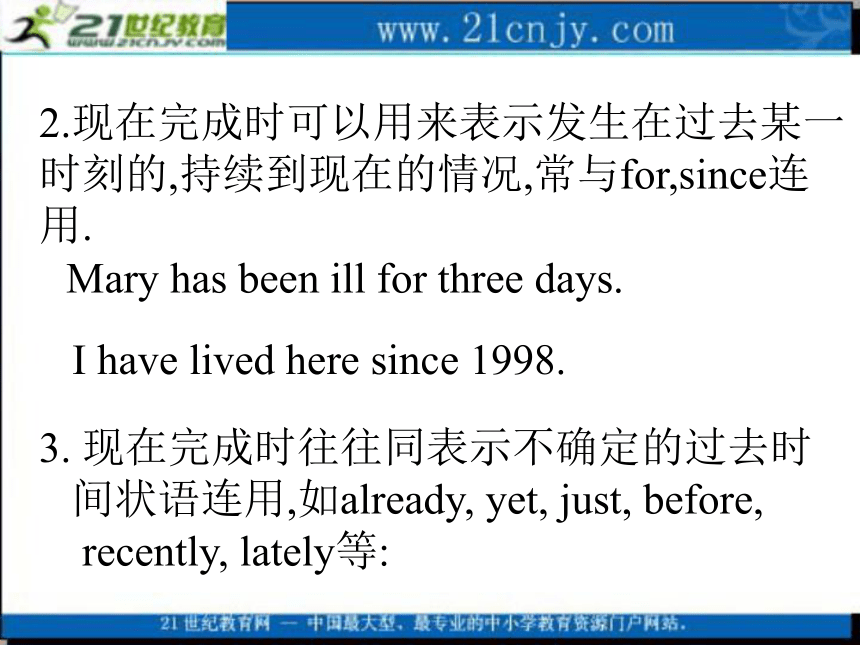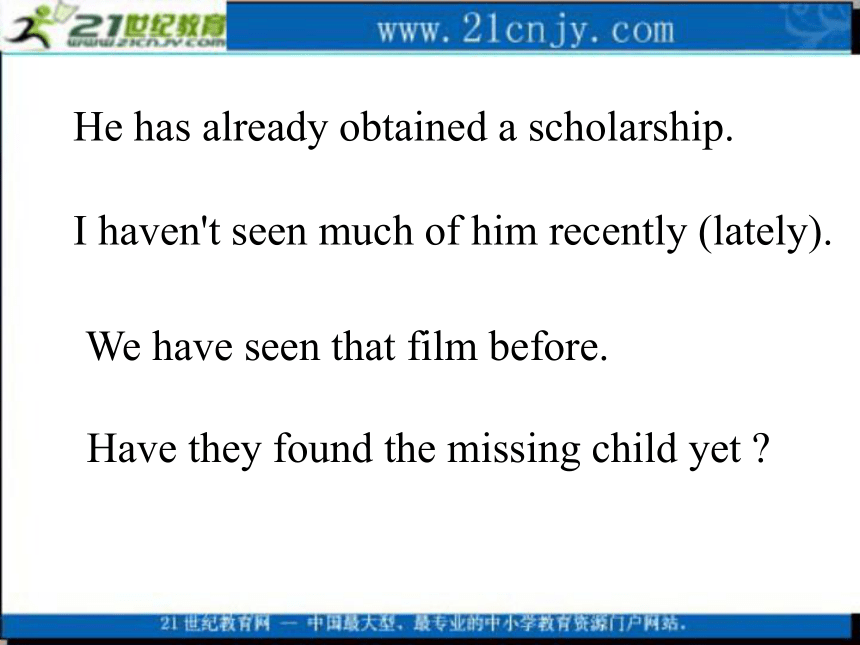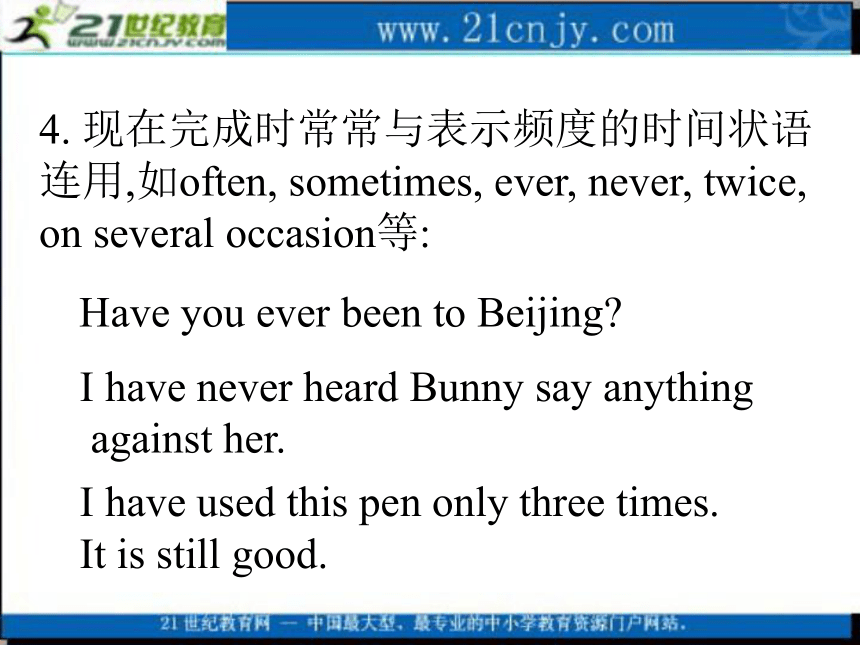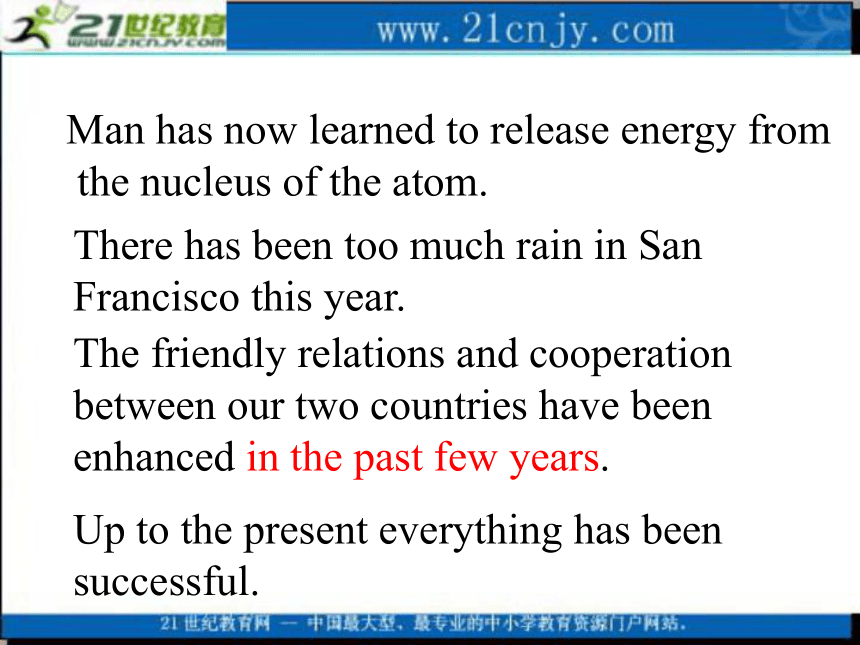module4 a social survey—my neighbourhood grammmar课件(外研版必修1)
文档属性
| 名称 | module4 a social survey—my neighbourhood grammmar课件(外研版必修1) |  | |
| 格式 | rar | ||
| 文件大小 | 314.5KB | ||
| 资源类型 | 教案 | ||
| 版本资源 | 外研版 | ||
| 科目 | 英语 | ||
| 更新时间 | 2009-08-20 22:05:00 | ||
图片预览







文档简介
课件18张PPT。外研版高中一年级
(第1 册)
Module 4 A social survey—My neighborhood
Grammar
1.现在完成时用来表示现在之前已发生或完
成的动作或状态,但其结果却和现在有联系,
也就是说,动作或状态发生在过去但它的影
响现在还存在. I have lost my wallet.(含义是:现在我没有钱花了.) Jane has laid the table.(含义是:已可以吃饭了.) Michael has been ill.(含义是:现在仍然很虚弱) 2.现在完成时可以用来表示发生在过去某一
时刻的,持续到现在的情况,常与for,since连
用. Mary has been ill for three days. I have lived here since 1998. 3. 现在完成时往往同表示不确定的过去时
间状语连用,如already, yet, just, before,
recently, lately等: He has already obtained a scholarship. I haven't seen much of him recently (lately).We have seen that film before. Have they found the missing child yet ?4. 现在完成时常常与表示频度的时间状语
连用,如often, sometimes, ever, never, twice,
on several occasion等: Have you ever been to Beijing?I have never heard Bunny say anything
against her. I have used this pen only three times.
It is still good. George has met that gentleman on several
occasions.5. 现在完成时还往往可以同包括现在时间
在内的时间状语连用,如now, up to these
few days/weeks/months/years, this morning/
week/month/year, now, just, today,
up to present, so far等: Peter has written six papers so far. Man has now learned to release energy from
the nucleus of the atom. There has been too much rain in San
Francisco this year. The friendly relations and cooperation
between our two countries have been
enhanced in the past few years. Up to the present everything has been
successful. 6. 现在完成时表示现在之前业已完成的动作,虽然其效果或影响仍然存在但已不再继续,但是有一些现在完成时的句子,在后面加上for+一段时间,则现在完成时的动作就表示延续性. Thomas has studied Russian.(现在不再学俄语) Thomas has studied Russian for three years. (=Thomas began to study Russian three
ago, and is still studying it now). 7. 现在完成时还可以用来表示过去的一
个时间到现在这段时间内重复发生的动作. We have had four texts this semester. 现在完成时的“完成用法”和“未完成用法 1.现在完成时的"完成用法" 现在完成时的“完成用法”指的是动作发生
在过去某一时刻并已结束,但该动作对现
在产生了影响,与现在情况具有因果关系。 He has turned off the light 他已把灯关了。 (动作结束于过去,但说明的是现在的情况
--灯现在不亮了。) 现在完成时“完成用法”的特点是动作不延
续,因此,该时态只能与表示不定的过去
时间状语(如:already,yet,before,
recently等)、频度时间状语(如:never,
ever,once等)、包括现在时刻在内的时间
状语(如:this morning / month /year...,
today等)连用。 Have you found your pen yet?
你已找到你的钢笔了吗? 2.现在完成时的"未完成用法" 现在完成时的“未完成用法”指的是动作
开始于过去某一时刻,一直延续到现在,
或可能还要继续下去。 He has lived here since 1978. 从1978年以来,他一直住在这儿。 (动作起始于1978年,一直住到现在,
可能还要继续住下去。) I have been in the army for more than 5 years. 我在部队已经呆了五年多了。 (动作开始于5年前,一直延续至今,有可
能还要继续下去。) 此种用法的句中常需一个表示一段时间
的状语(由since或for引导),或表示与现在
时刻相连的时间状语(如:up to now,so far)
等。 I have heard nothing from him up to now. 到目前为止我没有他的任何消息。 注意:(1)现在完成时的未完成用法只适
用于延续性动词,不可用于终止性动词,
即瞬间完成或延续时间很短的动词。
如:come,go,arrive,leave,join,
become,die等。 (2)现在完成时常见两种句型: ①主语+have / has been+for短语 ②It is+一段时间+ since从句 He has been in the League for three years.
或It is three years since he joined the League. 练习题
1. Jack ____ over five lessons by seven
o’clock. Then he ____ a rest.
went ; took B. went; had taken
C. had gone; took D. had gone ; had takenc.2. We ____ out by that time that he ____
spy for a long time.
had found; had been B. had found; was
C. found; had been D. found ;was
3. Before the news ____ him, he ____
to know about it.
reaches; has got B. reached; had got
C. reached ;got D. had reached; got
4. I _____ him a second letter before
I ____ from him.
wrote; heard B. wrote; had heard
C. had written ; heard D. have written; hearABC 5. People ____ that the soldiers _____ fighting
A. say ; had stopped B. said ;has stopped
C. say; stopped D. said ;had stopped
6 They _______ for five hours when they
______ in New York.
A. flew ; arrived B. had flown ; had arrived
C. flew ; had arrived D. had flown; arrived
7. She ____ that it _____ for two days by
that day.
A. says; has rained B. says; had rained
C. said ; had rained D. said; rainedDDC 8. John _____ there since the year before,
so he _____ them.
A. had worked ; knew
B. had worked; had known
C. worked; knew
D. worked ;had known
9. He _____ angry because he ____ for a
long time.
A. had got; had waited B. got ; waited
C. had got; waited D. got ; had waitedADThankyou
(第1 册)
Module 4 A social survey—My neighborhood
Grammar
1.现在完成时用来表示现在之前已发生或完
成的动作或状态,但其结果却和现在有联系,
也就是说,动作或状态发生在过去但它的影
响现在还存在. I have lost my wallet.(含义是:现在我没有钱花了.) Jane has laid the table.(含义是:已可以吃饭了.) Michael has been ill.(含义是:现在仍然很虚弱) 2.现在完成时可以用来表示发生在过去某一
时刻的,持续到现在的情况,常与for,since连
用. Mary has been ill for three days. I have lived here since 1998. 3. 现在完成时往往同表示不确定的过去时
间状语连用,如already, yet, just, before,
recently, lately等: He has already obtained a scholarship. I haven't seen much of him recently (lately).We have seen that film before. Have they found the missing child yet ?4. 现在完成时常常与表示频度的时间状语
连用,如often, sometimes, ever, never, twice,
on several occasion等: Have you ever been to Beijing?I have never heard Bunny say anything
against her. I have used this pen only three times.
It is still good. George has met that gentleman on several
occasions.5. 现在完成时还往往可以同包括现在时间
在内的时间状语连用,如now, up to these
few days/weeks/months/years, this morning/
week/month/year, now, just, today,
up to present, so far等: Peter has written six papers so far. Man has now learned to release energy from
the nucleus of the atom. There has been too much rain in San
Francisco this year. The friendly relations and cooperation
between our two countries have been
enhanced in the past few years. Up to the present everything has been
successful. 6. 现在完成时表示现在之前业已完成的动作,虽然其效果或影响仍然存在但已不再继续,但是有一些现在完成时的句子,在后面加上for+一段时间,则现在完成时的动作就表示延续性. Thomas has studied Russian.(现在不再学俄语) Thomas has studied Russian for three years. (=Thomas began to study Russian three
ago, and is still studying it now). 7. 现在完成时还可以用来表示过去的一
个时间到现在这段时间内重复发生的动作. We have had four texts this semester. 现在完成时的“完成用法”和“未完成用法 1.现在完成时的"完成用法" 现在完成时的“完成用法”指的是动作发生
在过去某一时刻并已结束,但该动作对现
在产生了影响,与现在情况具有因果关系。 He has turned off the light 他已把灯关了。 (动作结束于过去,但说明的是现在的情况
--灯现在不亮了。) 现在完成时“完成用法”的特点是动作不延
续,因此,该时态只能与表示不定的过去
时间状语(如:already,yet,before,
recently等)、频度时间状语(如:never,
ever,once等)、包括现在时刻在内的时间
状语(如:this morning / month /year...,
today等)连用。 Have you found your pen yet?
你已找到你的钢笔了吗? 2.现在完成时的"未完成用法" 现在完成时的“未完成用法”指的是动作
开始于过去某一时刻,一直延续到现在,
或可能还要继续下去。 He has lived here since 1978. 从1978年以来,他一直住在这儿。 (动作起始于1978年,一直住到现在,
可能还要继续住下去。) I have been in the army for more than 5 years. 我在部队已经呆了五年多了。 (动作开始于5年前,一直延续至今,有可
能还要继续下去。) 此种用法的句中常需一个表示一段时间
的状语(由since或for引导),或表示与现在
时刻相连的时间状语(如:up to now,so far)
等。 I have heard nothing from him up to now. 到目前为止我没有他的任何消息。 注意:(1)现在完成时的未完成用法只适
用于延续性动词,不可用于终止性动词,
即瞬间完成或延续时间很短的动词。
如:come,go,arrive,leave,join,
become,die等。 (2)现在完成时常见两种句型: ①主语+have / has been+for短语 ②It is+一段时间+ since从句 He has been in the League for three years.
或It is three years since he joined the League. 练习题
1. Jack ____ over five lessons by seven
o’clock. Then he ____ a rest.
went ; took B. went; had taken
C. had gone; took D. had gone ; had takenc.2. We ____ out by that time that he ____
spy for a long time.
had found; had been B. had found; was
C. found; had been D. found ;was
3. Before the news ____ him, he ____
to know about it.
reaches; has got B. reached; had got
C. reached ;got D. had reached; got
4. I _____ him a second letter before
I ____ from him.
wrote; heard B. wrote; had heard
C. had written ; heard D. have written; hearABC 5. People ____ that the soldiers _____ fighting
A. say ; had stopped B. said ;has stopped
C. say; stopped D. said ;had stopped
6 They _______ for five hours when they
______ in New York.
A. flew ; arrived B. had flown ; had arrived
C. flew ; had arrived D. had flown; arrived
7. She ____ that it _____ for two days by
that day.
A. says; has rained B. says; had rained
C. said ; had rained D. said; rainedDDC 8. John _____ there since the year before,
so he _____ them.
A. had worked ; knew
B. had worked; had known
C. worked; knew
D. worked ;had known
9. He _____ angry because he ____ for a
long time.
A. had got; had waited B. got ; waited
C. had got; waited D. got ; had waitedADThankyou
